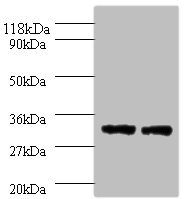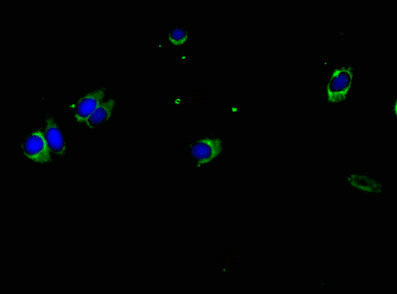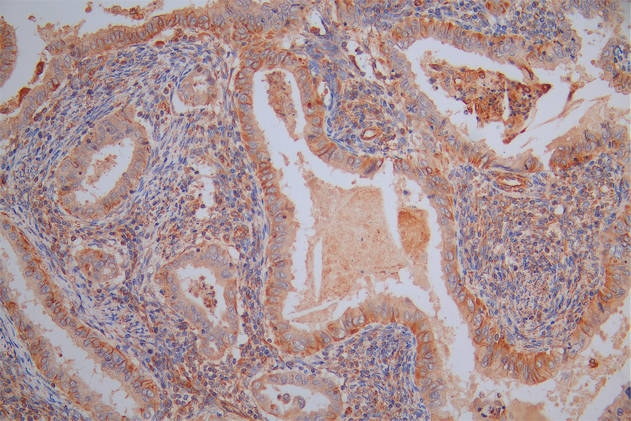HLA-DPA1 Antibody
-
中文名稱:HLA-DPA1兔多克隆抗體
-
貨號:CSB-PA14819A0Rb
-
規(guī)格:¥440
-
圖片:
-
Western blot
All lanes: HLA-DPA1 antibody at 2µg/ml
Lane 1: 293T whole cell lysate
Lane 2: HepG2 whole cell lysate
Secondary
Goat polyclonal to rabbit IgG at 1/10000 dilution
Predicted band size: 30 kDa
Observed band size: 30 kDa -
Immunofluorescent analysis of Hela cells using CSB-PA14819A0Rb at dilution of 1:100 and Alexa Fluor 488-congugated AffiniPure Goat Anti-Rabbit IgG(H+L)
-
-
其他:
產(chǎn)品詳情
-
產(chǎn)品名稱:Rabbit anti-Homo sapiens (Human) HLA-DPA1 Polyclonal antibody
-
Uniprot No.:
-
基因名:
-
別名:HLA-DPA1 antibody; HLA-DP1A antibody; HLASBHLA class II histocompatibility antigen antibody; DP alpha 1 chain antibody; DP(W3) antibody; DP(W4) antibody; HLA-SB alpha chain antibody; MHC class II DP3-alpha antibody; MHC class II DPA1 antibody
-
宿主:Rabbit
-
反應種屬:Human
-
免疫原:Recombinant Human HLA class II histocompatibility antigen, DP alpha 1 chain protein (29-222AA)
-
免疫原種屬:Homo sapiens (Human)
-
標記方式:Non-conjugated
本頁面中的產(chǎn)品,HLA-DPA1 Antibody (CSB-PA14819A0Rb),的標記方式是Non-conjugated。對于HLA-DPA1 Antibody,我們還提供其他標記。見下表:
-
克隆類型:Polyclonal
-
抗體亞型:IgG
-
純化方式:>95%, Protein G purified
-
濃度:It differs from different batches. Please contact us to confirm it.
-
保存緩沖液:Preservative: 0.03% Proclin 300
Constituents: 50% Glycerol, 0.01M PBS, PH 7.4 -
產(chǎn)品提供形式:Liquid
-
應用范圍:ELISA, WB, IF
-
推薦稀釋比:
Application Recommended Dilution WB 1:1000-1:5000 IF 1:50-1:200 -
Protocols:
-
儲存條件:Upon receipt, store at -20°C or -80°C. Avoid repeated freeze.
-
貨期:Basically, we can dispatch the products out in 1-3 working days after receiving your orders. Delivery time maybe differs from different purchasing way or location, please kindly consult your local distributors for specific delivery time.
-
用途:For Research Use Only. Not for use in diagnostic or therapeutic procedures.
相關產(chǎn)品
靶點詳情
-
功能:Binds peptides derived from antigens that access the endocytic route of antigen presenting cells (APC) and presents them on the cell surface for recognition by the CD4 T-cells. The peptide binding cleft accommodates peptides of 10-30 residues. The peptides presented by MHC class II molecules are generated mostly by degradation of proteins that access the endocytic route, where they are processed by lysosomal proteases and other hydrolases. Exogenous antigens that have been endocytosed by the APC are thus readily available for presentation via MHC II molecules, and for this reason this antigen presentation pathway is usually referred to as exogenous. As membrane proteins on their way to degradation in lysosomes as part of their normal turn-over are also contained in the endosomal/lysosomal compartments, exogenous antigens must compete with those derived from endogenous components. Autophagy is also a source of endogenous peptides, autophagosomes constitutively fuse with MHC class II loading compartments. In addition to APCs, other cells of the gastrointestinal tract, such as epithelial cells, express MHC class II molecules and CD74 and act as APCs, which is an unusual trait of the GI tract. To produce a MHC class II molecule that presents an antigen, three MHC class II molecules (heterodimers of an alpha and a beta chain) associate with a CD74 trimer in the ER to form a heterononamer. Soon after the entry of this complex into the endosomal/lysosomal system where antigen processing occurs, CD74 undergoes a sequential degradation by various proteases, including CTSS and CTSL, leaving a small fragment termed CLIP (class-II-associated invariant chain peptide). The removal of CLIP is facilitated by HLA-DM via direct binding to the alpha-beta-CLIP complex so that CLIP is released. HLA-DM stabilizes MHC class II molecules until primary high affinity antigenic peptides are bound. The MHC II molecule bound to a peptide is then transported to the cell membrane surface. In B-cells, the interaction between HLA-DM and MHC class II molecules is regulated by HLA-DO. Primary dendritic cells (DCs) also to express HLA-DO. Lysosomal microenvironment has been implicated in the regulation of antigen loading into MHC II molecules, increased acidification produces increased proteolysis and efficient peptide loading.
-
基因功能參考文獻:
- HLA-DPA1 and HLA-DPB1 variants can determine susceptibility or protective effect against Hepatitis B virus infection in an Indonesian population. PMID: 27051043
- The HLA-B*42, HLA-C*17, HLA-DPA1*03, and HLA-DPB1*105 genotypes were associated with allergic asthma and the HLA-B*48 genotype with the nonallergic phenotype. The presence of the haplotype HLA-DPA1*03 DQA*05 was associated with allergic asthma, and the presence of HLA-DPA1*03 and the absence of HLA-DQA*05 with nonallergic asthma. PMID: 28380482
- Single-nucleotide polymorphism in HLA-DPA1 gene is associated with sclerotic graft-versus-host disease. PMID: 27313329
- Single-nucleotide polymorphism in HLA-DP is associated with cervical cancer susceptibility. PMID: 26711785
- rs3077 in HLA-DPA1 is a significantly associated SNP associated with chronic hepatitis B virus infection and viral clearance. PMID: 24846544
- This resource provides population estimates of the frequencies of HLA alleles at these eight loci in the three population groups, particularly for HLA-DPA1 and HLA-DPB1 that were not assayed in HapMap. PMID: 24698974
- DPA1*02:01- DPB1*14:01 and DPA1*02:01- DPB1*17:01 haplotypes provide considerable protection effect against Posner-Schlossman syndrome. PMID: 25863099
- HLA-DP gene polymorphisms are strongly associated with chronic hepatitis B virus infection. PMID: 25449085
- The study suggests that HLA-DPA1/B1 loci are candidate susceptibility regions that have some marker single nucleotide polymorphisms for both chronic hepatitis C virus infection and F protein generation in the Han Chinese population. PMID: 24897020
- Single nucleotide polymorphisms rs3077 and rs9277378 in HLA-DPA1 and HLA-DPB1 are significantly associated with protective effects against chronic hepatitis B. PMID: 24465836
- It related to persistence of hepatitis B virus (HBV) infection and viral load in chronic HBV. PMID: 23980639
- HLA-DPA1 and DPB1 allele frequencies and haplotypes of the population of Guadeloupe were most similar to African populations, with characteristic alleles and haplotypes that bespeaks the admixture with other ethnicities. PMID: 24405442
- Crystal structure of the extracellular region of the HLA-DPA1/DPB1 heterodimer, in complex with the major antigenic peptide from the Japanese cedar pollen allergen. PMID: 25020231
- Data indicate that CD4+ T cell allorecognition of HLA-DP is significantly affected by DPA1 polymorphism. PMID: 24462895
- Studied three HLA-DP and IL28B SNPs of CHB patients with and without spontaneous HBsAg seroclearance.Haplotype analysis of HLA-DP polymorphisms showed association with HBsAg seroclearance. PMID: 23449268
- HLA-DP SNPs rs3077, rs9277378 and rs3128917 were associated with chronicity of HBV disease in the Chinese PMID: 23825586
- HLA-DP polymorphisms affect affect genotype B hepatitis B virus clearance, regulate immune selection of viral mutations, and influence cirrhosis and hepatocellular carcinoma risks contributed by hepatitis B virus mutations PMID: 24006435
- This is the first study that confirms the association of HLA markers and haplotypes around HLA-DPA1 and HLA-DPB1 with ankylosing spondylitis. PMID: 23459078
- Data indicate that comparing to GG haplotype of rs3077 (near HLA-DPA1 region) and rs9277535 (near HLA-DPB1 region), GA haplotype had a higher chance of achieving spontaneous HBsAg loss. PMID: 23326374
- Significant associations of HLA-DP rs3077 and rs9277535 with increased risks of cervical cancer in a Chinese population were found. PMID: 23428460
- HLA-DPA1 genetic variation, proxies for early life immune modulation and childhood acute lymphoblastic leukemia. PMID: 22923493
- HLA-DP has a role in protection against chronic hepatitis B and viral clearance in Japanese and Koreans PMID: 22737229
- HLA-DPA1 variant is associated with hepatitis B virus infection. PMID: 22448225
- A novel variant in the HLA-DPB1 3'UTR region, 496A/G, is associated significantly with HBV recovery in European and African-American populations. PMID: 22496224
- Genetic variants of the HLA-DP genes are risk factors for the development of hepatocellular carcinoma in chinese patients. PMID: 22105689
- variants previously associated with chronic hepatitis B are also strongly associated with mRNA expression of HLA-DPA1 and HLA-DPB1, suggesting that expression of these genes is important in control of HBV. PMID: 21346778
- genetic variants in the HLA-DPA1 and HLA-DPB1 locus are associated with the risk of pediatric asthma in Asian populations. PMID: 21814517
- HLA - DPA1 rs3077 T was strongly associated with decreased risk of chronic hepatitis B virus infection (odds ratio, .62; P = .001), consistent with the previous report. PMID: 21402545
- Genetic variants in the HLA-DP locus are strongly associated with persistent chronic hepatitis B virus infection in the Han Chinese population. PMID: 21274863
- DPA1*020107 was identified from a woman of Ugandan origin by a taxonomy-based sequence analysis of human leukocyte antigen DPA1. It is identical to DPA1*020101 with the exception of a single nucleotide synonymous substitution at codon 58 (GGC-->GGT). PMID: 20470845
- HLA-DPA1 allelic and haplotypic diversity contributes significantly to the risk for type 1 diabetes PMID: 20424227
- HLA-DPA1 promoter haplotypes are differently distributed in southern Chinese ethnic groups PMID: 15713216
- Our findings show that genetic variants in the HLA-DPA1 locus are strongly associated with risk of persistent infection with hepatitis B virus. PMID: 19349983
顯示更多
收起更多
-
亞細胞定位:Cell membrane; Single-pass type I membrane protein. Endoplasmic reticulum membrane; Single-pass type I membrane protein. Golgi apparatus, trans-Golgi network membrane; Single-pass type I membrane protein. Endosome membrane; Single-pass type I membrane protein. Lysosome membrane; Single-pass type I membrane protein. Note=The MHC class II complex transits through a number of intracellular compartments in the endocytic pathway until it reaches the cell membrane for antigen presentation.
-
蛋白家族:MHC class II family
-
數(shù)據(jù)庫鏈接:
Most popular with customers
-
-
YWHAB Recombinant Monoclonal Antibody
Applications: ELISA, WB, IHC, IF, FC
Species Reactivity: Human, Mouse, Rat
-
Phospho-YAP1 (S127) Recombinant Monoclonal Antibody
Applications: ELISA, WB, IHC
Species Reactivity: Human
-
-
-
-
-





















